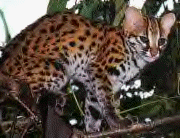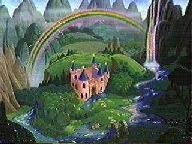| General Description The Leopard Cat is about
the size of a house cat, with longer legs. Their
weight ranges from 7 to 15 pounds. The base fur
color is usually a pale brown, but can also be
red or grey. The cats living in the cooler
climates tend to be larger and lighter in color.
Those in the warm humid areas are smaller and
darker. The cat is covered with dark brown to
black spots or rosettes. Leopard Cats usually
have four stripes running from the forehead to
behind the neck. The spotted belly, chest,
throat, and cheek-flashes are usually white. The
Leopard Cat has a large white spot on the back of
their long rounded black ears. The cat's head is
relatively small and has large eyes. Their tail
is spotted at the base. Rings move up the tail to
the black tip. Soles of the feet are dark brown.
Singapore
Zoological Gardens

Names
| English |
Bengal cat |
| French |
chat leopard du
Bengale |
| German |
Bengalkatze |
| Spanish |
gato bengali, gato
de Bangala |
| Chinese |
jin chien mao, bao
mao
(called the Money Cat in China) |
| Malaysian |
kucing batu, thit
kyuk |
| Russian |
Amurskii
kot, bengalskaya koshka |
| Indian |
chita billi |

Distribution and Habitat
Leopard Cats are one of
the most common and widely distributed wild cats
of Southern Asia. The cats can be found not only
in Asia but also in Korea, China, and Eastern Russia.
Their range includes the islands of Sumatra,
Bali, Java, Borneo, Philippines, and Taiwan. They
can live in tropical forests, scrublands, pine
forests, secondgrowth woodland, semideserts, and
agricultural regions.

Subspecies
Because of the Leopard
Cat's extended range, this has led to
fragmentation, resulting a number of subspecies.
| F.(P.)b.
bengalensis |
India to
Indo-China and Yunnan |
| F.(P.)b.
borneoenisis |
Borneo |
| F.(P.)b. chinensis |
China and Taiwan |
| F.(P.)b.
euptilura |
The
Far Eastern forest cat, East Siberia |
| F.(P.)b.
horsfieldi |
Kashmir to Sikkim |
| F.(P.)b.
javanensis |
Java and Bali |
| F.(P.)b.
amanchurica |
Manchuria |
| F.(P.)b. minuta |
Philippines |
| F.(P.)b. sumatrans |
Sumatra |
| F.(P.)b.
trevelyani |
North Kashmir to
South Baluchistan, Pakistan |
Source:
The
Wild Cat Trust

Hunting and Diet
The Leopard Cat generally
hunts alone at night. They hunt on the ground or
ambush their prey from trees, surviving on a diet
of rodents, small birds, amphibians, fish,
insects, reptiles, eggs, and small mammals,
including small deer. They may also dine on
fallen bats and swifts near caves.

Behavior
The Leopard Cat is
primarily nocturnal, although Leopard Cat
activity has been spotted during the day. A
male's territory ranges from less than one
kilometer on an island to nine kilometers on the
mainland. They make their dens in tree hollows,
small caves, or in holes beneath the roots of
fallen trees. Leopard cats are strong swimmers,
thus how they have populated offshore islands.
According to Barbara Sleeper, author of Wild Cats
of the World, "the type specimen was
originally caught swimming in the Bay of
Bengal." Additionally, they are agile
climbers, being at home in trees. The Leopard Cat
lifespan is about ten to fifteen years.
Unless you are experienced
with wild cats and have had the wild cat since it
was a new born kitten, in general, Leopard Cats
do not make good pets. Being a wild animal and
solitary in nature, they do not welcome being
touched or handled by humans. Also due to their
wild nature, they could pose a threat to children
and other pets. Many states require special
permits to have wild cats.
Singapore
Zoological Gardens
Reproduction
Females give birth to one
to four kittens, usually two to three, after a
gestation period of nine to ten weeks (56 to 72
days). The male has been known to help rear the
kittens. At about ten days old, the kittens open
their eyes. They eat meat at about three weeks,
and leave the den at about four weeks. The
Leopard Cat reaches sexual maturity at eighteen
months.

Threats
The principle threat to
the Leopard Cat, as well as other wild animals,
is habitat destruction. This is especially a
problem for cats and other species living on
islands, where their populations and habitat are
small to begin with. The Leopard Cat is
considered a pest and killed when they raid
poultry farms. On the contrary, however, palm oil
and rubber tree plantations report that the cat
helps to control the rodent population. The
Leopard Cat, like so many other wild cats, is
hunted for the fur trade, trophies, sport, and
meat for the dinner table. Throughout Asia, pelts
are sold in gift shops, and about 200,000 pelts a
year are shipped from China.

"Animals are among
the conductors of life's
greatest symphonies. They exist not solely
for our convenience or fancy, but are an
important rhythm to the planet we share."
Darcy Bell Symes, Animals
Magazine, 1981

Written by Holly Erickson
|







